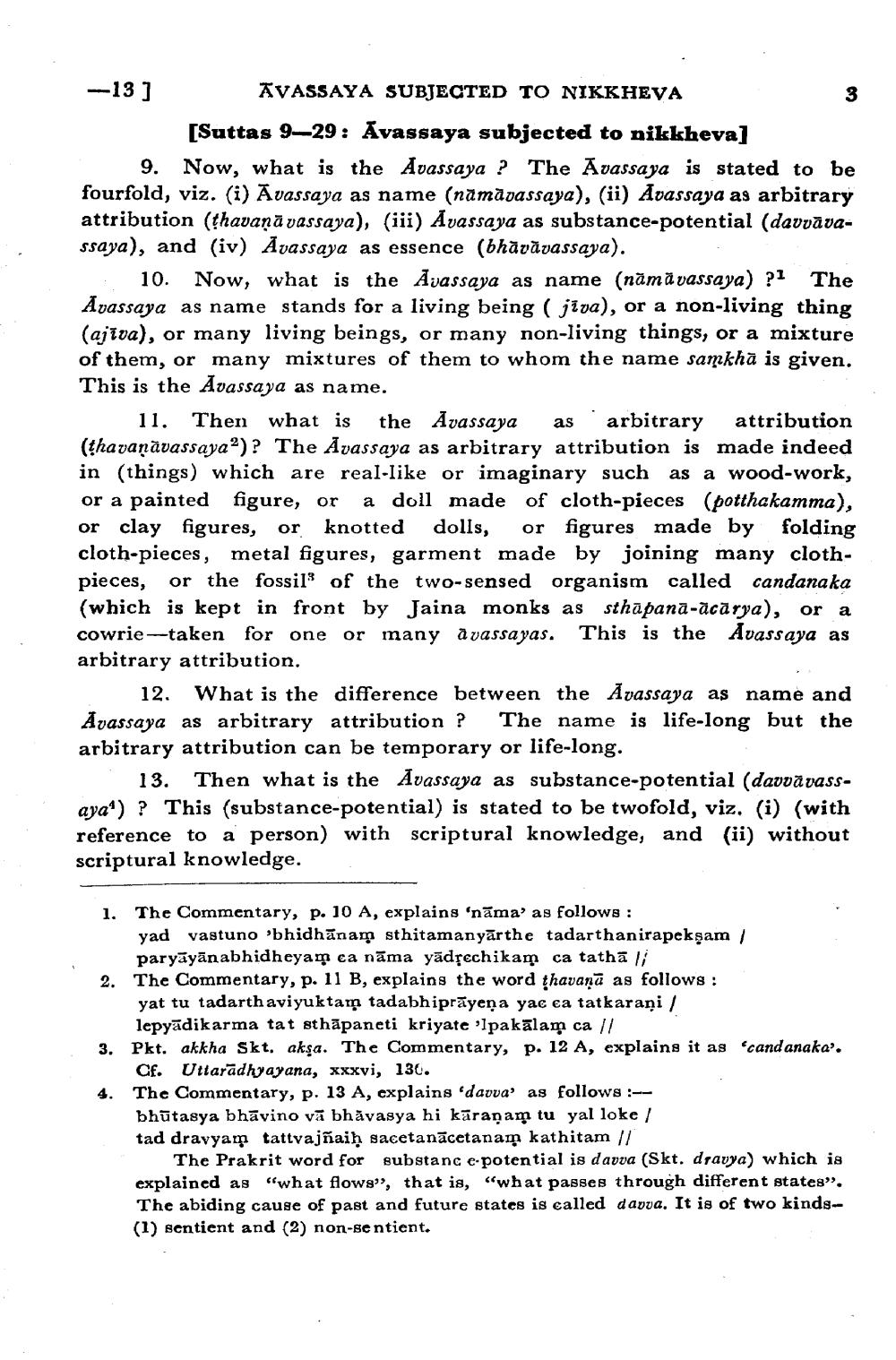________________
-13]
AVASSAYA SUBJECTED TO NIKKHEVA
[Suttas 9-29: Avassaya subjected to nikkheva]
9. Now, what is the Avassaya? The Avassaya is stated to be fourfold, viz. (i) Avassaya as name (nāmāvassaya), (ii) Avassaya as arbitrary attribution (thavaṇā vassaya), (iii) Avassaya as substance-potential (davvavassaya), and (iv) Avassaya as essence (bhāvāvassaya).
10. Now, what is the Avassaya as name (nāmāvassaya) ?1 The Avassaya as name stands for a living being ( jiva), or a non-living thing (ajiva), or many living beings, or many non-living things, or a mixture of them, or many mixtures of them to whom the name samkhā is given. This is the Avassaya as name.
11. Then what is the Avassaya as arbitrary attribution (thavaṇāvassaya2)? The Avassaya as arbitrary attribution is made indeed in (things) which are real-like or imaginary such as a wood-work, or a painted figure, or a doll made of cloth-pieces (potthakamma), or clay figures, or knotted dolls, or figures made by folding cloth-pieces, metal figures, garment made by joining many clothpieces, or the fossil" of the two-sensed organism called candanaka (which is kept in front by Jaina monks as sthāpanā-ācārya), or a cowrie taken for one or many a vassayas. This is the Avassaya as arbitrary attribution.
3
12. What is the difference between the Avassaya as name and Avassaya as arbitrary attribution ? The name is life-long but the arbitrary attribution can be temporary or life-long.
13. Then what is the Avassaya as substance-potential (davvāvassaya1)? This (substance-potential) is stated to be twofold, viz. (i) (with reference to a person) with scriptural knowledge, and (ii) without scriptural knowledge.
1. The Commentary, p. 10 A, explains 'nama' as follows:
yad vastuno 'bhidhanam sthitamanyar the tadarthanirapekşam / paryāyānabhidheyam ca nama yādṛechikam ca tatha |;
2. The Commentary, p. 11 B, explains the word thavana as follows:
yat tu tadarthaviyuktam tadabhiprayeṇa yac ca tatkarani / lepyādikarma tat sthapaneti kriyate 'lpakālam ca //
Pkt. akkha Skt. akşa. The Commentary, p. 12 A, explains it as 'cand anaka'. Cf. Uttaradhyayana, xxxvi, 130.
The Commentary, p. 13 A, explains 'davva' as follows:-- bhūtasya bhāvino va bhāvasya hi karanam tu yal loke / tad dravyam tattvajñaiḥ sacetanacetanam kathitam //
The Prakrit word for substanc e-potential is davva (Skt. dravya) which is explained as "what flows", that is, "what passes through different states". The abiding cause of past and future states is called davva. It is of two kinds-(1) sentient and (2) non-sentient.
3.
4.




